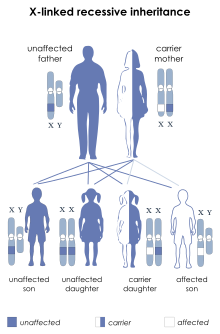
Back سوء التغذية العضلي لبيكر Arabic Beckerova mišićna distrofija BS Distrofia muscular de Becker Catalan نەخۆشی دیسترۆفی ماسوولکەیی بێکەر CKB Beckerova svalová dystrofie Czech Muskeldystrophie Becker-Kiener German Μυϊκή δυστροφία Μπέκερ Greek Distrofia muscular de Becker Spanish دیستروفی ماهیچهای بکر Persian Beckerin lihasdystrofia Finnish
| Becker muscular dystrophy | |
|---|---|
| Other names | Benign pseudohypertrophic muscular dystrophy[1] |
 | |
| X-linked recessive is the manner in which this condition is inherited | |
| Specialty | Neurology |
| Symptoms | Severe upper extremity muscle weakness,[2] Toe-walking[3] |
| Causes | Mutations in DMD gene[4] |
| Diagnostic method | Neurological exam, muscle exam[3] |
| Treatment | No current cure, Physical therapy [3] |
Becker muscular dystrophy (BMD) is an X-linked recessive inherited disorder characterized by slowly progressing muscle weakness of the legs and pelvis. It is a type of dystrophinopathy.[5][3] The cause is mutations and deletions in any of the 79 exons encoding the large dystrophin protein, essential for maintaining the muscle fiber's cell membrane integrity.[6] Becker muscular dystrophy is related to Duchenne muscular dystrophy in that both result from a mutation in the dystrophin gene, however the hallmark of Becker is milder in-frame deletions.[4] and hence has a milder course, with patients maintaining ambulation till 50–60 years if detected early.[7][8]
While there is no known cure, management strategies such as physical therapy, braces, and corrective surgery may alleviate symptoms.[9] Assisted ventilation may be required in those with weakness of breathing muscles.[6] Several drugs designed to address the root cause are currently available including gene therapy (Elevidys).[6]
Other medications used include glucocorticoids (Deflazacort, Vamorolone); calcium channel blockers (Diltiazem); to slow skeletal and cardiac muscle degeneration, anticonvulsants to control seizures and some muscle activity, and Histone deacetylase inhibitors (Givinostat) to delay damage to dying muscle cells.[9][6] These patients do not require antisense drugs (Ataluren, Eteplirsen etc.) as certain percentage of dystrophin is already expressed.[6]
- ^ "Becker muscular dystrophy: MedlinePlus Medical Encyclopedia". medlineplus.gov. Archived from the original on 15 March 2017. Retrieved 30 July 2019.
- ^ Cite error: The named reference
patwas invoked but never defined (see the help page). - ^ a b c d "Becker muscular dystrophy". NIH. Archived from the original on 7 April 2016. Retrieved 17 April 2016.
- ^ a b "Becker muscular dystrophy | Genetic and Rare Diseases Information Center (GARD) – an NCATS Program". Archived from the original on 2016-04-28. Retrieved 2016-04-19.
- ^ "Duchenne and Becker muscular dystrophy". NIH.gov. NIH. Archived from the original on 24 March 2017. Retrieved 17 April 2016.
- ^ a b c d e Cite error: The named reference
NIH2016Rewas invoked but never defined (see the help page). - ^ Aslesh, Tejal; Maruyama, Rika; Yokota, Toshifumi (2018-01-02). "Skipping Multiple Exons to Treat DMD—Promises and Challenges". Biomedicines. 6 (1): 1. doi:10.3390/biomedicines6010001. ISSN 2227-9059. PMC 5874658. PMID 29301272.
- ^ "Muscular Dystrophy, Becker". NORD (National Organization for Rare Disorders). Archived from the original on 2021-10-31. Retrieved 2021-04-17.
- ^ a b Cite error: The named reference
NIH2016was invoked but never defined (see the help page).